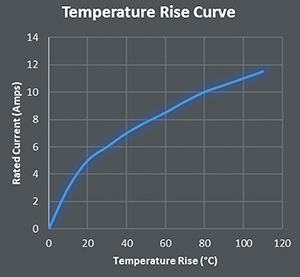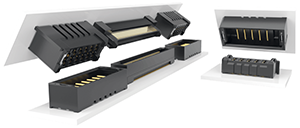
Power connectors do not need to be bulky and cumbersome. In fact, smaller connectors can hold the advantage in certain situations, so when looking for your next power connector, remember that bigger is not always better.
Power connectors are big. It comes with the physics. If you want to transmit more power through an electrical terminal, the easiest way to achieve this is to make the terminal larger and so the connector in which it lives also gets bigger.
For many applications, large power connectors can be an advantage. A large connector is simple to use, sometimes with screw- or bayonet-locking systems for reliability and robust screw terminals for attaching power cables.
However, not all applications allow the luxury of a large power connector. Modern trends are seeing power delivered to the printed circuit board (PCB) in ways not seen before. These trends are shaping the way that power is connected and manufacturers are developing new solutions that will be suitable for the next generation of electronic systems.
New trends in renewable energy
Concerns for the environment and the search for cheap energy have produced an enormous growth in the renewable energy sector. In farmlands around the world, traditional crops have given way to a new harvest: solar energy. Entire fields are covered with the latest solar technology that provides power to traditional distribution networks.
As an alternative to solar power, homes and businesses are turning to microgeneration. High-efficiency technology enables users to create power locally as a real alternative to the conventional generation of power on a massive scale. All these alternatives require sophisticated hardware to maintain the quality of the power delivered to the consumer while being cost-effective enough to provide real economic advantages.
The power of data centres
The future of data communication lies within data centres. The Internet is a huge consumer of power and the demand will continue to grow. Widely cited studies are predicting that by the end of the decade, a fifth of all the energy generated in the world will be used within the IT sector. That is an incredible amount of power that needs to be carried to PCBs and we will need the latest technologies to deliver this performance.
With so much power being carried around in an enclosed environment, power connections are not just a matter of plugging two wires together and hoping for the best. There are several aspects to creating a power connector that need to be considered.
The resistance
Every electrical circuit has resistance. The value may be small, but when passing power through that circuit, any resistance causes some of the energy to be converted into heat. With enough power, this can cause a rise in the temperature of the terminal and therefore everything else around it. For this reason, it is important to understand how much heat is generated. Many connector manufacturers publish a temperature derating chart for their terminals. This chart shows how the temperature will rise above that of the surroundings as more current is passed through the terminal.

In the example shown in Figure 1, we can see that a current of 10 A passing through the contact will cause a temperature rise above ambient of 80°C. Placing this information into a hypothetical real-world installation, if the ambient temperature is a steady 20°C (nominal room temperature), the connector’s temperature will rise to 100°C. That is enough to cause injury to unprotected skin.
We also need to consider the published operating temperature of the connector itself. This will often be limited by the materials used in the connector’s design, in particular the plastic used for the insulator. In our hypothetical example, the operating temperature range of the connector might be 105°C, typical for commercial-grade connectors. An 80°C temperature rise above room temperature will be within acceptable limits. However, if the ambient temperature is higher – for example, in the server cabinet of a data centre – then the same increase in temperature may risk damage to the connector.
Solving the temperature problem
There are several solutions to the problem of temperature and current ratings. The simplest approach is to use a connector with larger contacts. One of the key factors governing the current rating of an electrical terminal is its mass. A larger terminal with more material should have a lower resistance and be able to carry more power. However, as we are trying to find solutions for the compact designs of the future, a larger connector is not always convenient.

Another way to solve the problem is to use a connector with a larger pitch. Pitch is the term used to describe the distance between terminals within electrical and electronic components. A greater pitch will aid in the dissipation of heat, which should lead to a reduced temperature rise for a given current. However, this will also result in a larger connector, which does not solve our design problem.
The thoughtful approach is to consider the contacts themselves. Conventional designs comprise a fixed male contact that is inserted into a socket or female. The mating area of the female terminal is split, or bifurcated and the two parts provide a constant force to ensure electrical continuity. The actual area of contact between the two terminals is small.
There are different methods to increase this contact area. Some replace the conventional terminal with a basket, or lamella, design. This is the approach taken by Amphenol with its SurLok single-pole connector. The basket is a separate cylindrical spring element that is housed within the female terminal and makes contact around the full 360° shape of the male. This greatly increases the contact surface area and improves the current rating. The same technology is used by other manufacturers who offer similar products.
Terminals using lamella contact technology often have a large price tag to go with their high performance. For more affordable solutions in commercial connectors, Molex provides an excellent example with its Mega-Fit range. Part of a large connector family, the Mega-Fit terminals use a stamped-and-formed design that offers six points of contact and current ratings of up to 23 A, even with hollow stamped-and-formed contacts.
Yet another solution is provided by the Samtec mPower board-mounted connector (Figure 2). The mPower replaces the conventional terminal with a flat blade to increase the contact surface area. With a pitch of only 2,00 mm, the mPower delivers current ratings of up to 21 A and the connector is designed to complement a wide range of Samtec’s high-speed data connectors like the Edge Rate family to create a complete board-to-board solution.
Bigger is not always better
There is another option which seems at first glance to defy logic: use a smaller connector. While this may sound counter-intuitive, the key concept to understand is that of power density. It is possible to obtain a better total current rating with connectors that use a larger number of smaller terminals.
To demonstrate this concept, let’s look at another example, this time using Harwin’s Gecko connector family. Gecko is a low-profile, board-to-wire and board-to-board connector that offers an alternative to other, larger connectors including the popular Micro-D.
We will compare the power density delivered by similar connectors of the Gecko and Micro-D families. In the example shown in Figure 3, a 26-pole Gecko connector shown in grey can deliver 52 A (26 contacts rated at 2 A per contact) in a length of 18,80 mm. This gives us a power density of nearly 70,3 A per 25,4 mm.
In contrast, the Micro-D delivers 75 A (25 contacts rated at 3 A per contact), but in a length of 30,10 mm. This results in a power density of 63,3 A per 25,4 mm. The Gecko allows 11% additional power to be delivered for a given length of connector. Therefore, although the individual contacts of the Gecko are smaller and offer a lower current rating, the overall footprint of the connector is smaller and therefore offers a greater power density.
Power connectors do not need to be bulky and cumbersome. In fact, smaller connectors can hold the advantage in certain situations, especially critical with the growth of data centres and alternative energy. The same technology can be applied to almost any application within electronics. When looking for your next power connector, remember that bigger is not always better.
© Technews Publishing (Pty) Ltd | All Rights Reserved